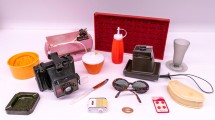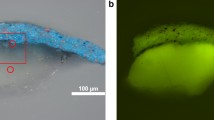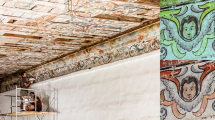Abstract
Wall paintings typically contain low concentrations of organic materials within a largely inorganic matrix and are characterised by their high porosity and long-term exposure to severe environmental conditions. The identification of organic materials within specific paint or plaster layers is challenging and the inherent characteristics of wall painting samples present further complications. Embedding materials (such as epoxy, polyester and acrylic-based resins) used to produce cross-sections often infiltrate porous and leanly bound samples, and compromise the interpretation of Fourier transform infrared attenuated total reflectance (FTIR-ATR) spectra and the qualitative identification of natural organic materials. An alternative method for the preparation of cross-sections of wall painting samples was developed using cyclododecane (C12H24) as a temporary consolidant and barrier coating to encapsulate the sample, and to provide necessary support to produce a cross-section through microtoming. Impacts of traditional and novel sample preparation techniques on the identification of organic materials with micro-FTIR-ATR were examined for both replica and real wall painting samples.








Similar content being viewed by others
References
Pique F (2007) A methodology for the identification of organic materials in wall paintings. In: Drdácký M, Chapuis M (eds) Safeguarded cultural heritage: understanding and viability for the enlarged Europe. Proceedings of the 7th European conference SAUVEUR, 31 May–3 June 2006, Prague, Czech Republic
Getty Conservation Institute (2008) Organic materials in wall paintings (OMWP) project. http://www.getty.edu/conservation/science/omwp/index.html. Accessed 8 April 2008
Derrick MR, Stulik D, Landry JM (1999) Infrared spectroscopy in conservation science. Getty Conservation Institute, Los Angeles
Casadio F, Toniolo L (2001) J Cult Herit 2:71–78
Schulz H, Kropp B (1993) Fresenius J Anal Chem 346:114–122
Chalmers JM, Everall NJ, Hewitson K, Chesters MA, Pearson M, Grady A, Ruzicka B (1998) Analyst 123:579–586
Chan K, Kazarian S (2007) Appl Spectrosc 61:48–54
Ricci C, Eliasson C, Macleod N, Newton P, Matousek P, Kazarian S (2007) Anal Bioanal Chem 389:1525–1532
van der Weerd J, Brammer H, Boon JJ, Heeren RMA (2002) Appl Spectrosc 56:275–283
Nevin A (2005) Z Kunsttechnol Konservierung 19:356–368
Mazzeo R, Joseph E, Prati S, Millemaggi A (2007) Anal Chim Acta 599:107–117
Salvado N, But S, Tobin MJ, Pantos E, Prag A, Pradell T (2005) Anal Chem 77:3444–3451
Cotte M, Checroun E, Susini J, Walter P (2007) Appl Phys A 89:841–848
Marengo E, Liparota M, Robotti E, Bobba M (2005) Anal Chim Acta 553:111–122
Hind AR, Bhargava SK, McKinnon A (2001) Adv Colloid Interface Sci 93:91–114
Sudo E, Esaki Y, Sugiura M, Murase A (2007) Appl Spectrosc 61:269–275
Khandekar N (2003) Rev Conserv 4:52–64
Wachowiak M (2004) JAIC 43(3):205–226
Derrick M, Souza L, Kieslich T, Florsheim H, Stulik D (1994) JAIC 33:227–247
Pilc J, White R (1995) Natl Gallery Tech Bull 16:73–84
Wyplosz N, Koper R, van der Weerd J, Heeren R, Boon J (2000) In: Art et Chimie, la couleur. CNRS, Paris
van der Weerd J, Heeren RMA, Boon JJ (2004) Stud Conserv 49:193–210
Boon J, Asahina S (2006) Microsc Microanal 12:1322–1323
Bogin S (2005) Z Kunsttechnol Konservierung 19:199–230
Jäegers E, Jäegers E (1999) Brit Mus Occas Pap 135:37–42
Brückle I, Thornton J, Nichols K, Strickler G (1999) JAIC 38:162–175
Stein R, Kimmel J, Marincola M, Klemm F (2000) JAIC 39:355–369
Muros V, Hirx J (2004) JAIC 43:75–89
Pitthard V, Griesser M, Stanek S, Bayerova T (2006) Macromol Symp 238:37–45
Acknowledgements
At the Getty Conservation Institute, Martin de Fonjaudran would like to warmly thank Dr. Giacomo Chiari for access to the analytical facilities, Herant Khanjian for instruction in FTIR microscopy, and Julie Arslonoglu (now at the Metropolitan Museum of Art) for suggesting the use of cyclododecane. Nevin would like to thank Sharon Cather and Dr. Aviva Burnstock (Courtauld Institute of Art) and Prof. Jaap Boon (FOM-AMOLF) for guidance during his MA research on FTIR-ATR, as well as Dr. Giancarlo Lanterna (Opificio delle Pietre Dure, Florence) for access to analytical facilities. Stephanie Bogin (Courtauld Institute of Art) and Emily Howe (private conservator) kindly provided samples for analysis, while Dr. Klaas Jan van den Berg (Instituut Collectie Nederland) perfomed Py-GC-MS analysis on samples from Valletta. This research formed part of the organic materials in wall paintings (OMWP) project, coordinated by the Getty Conservation Institute in collaboration with several conservation science laboratories, and the replica samples were made available by the project partner Laboratorio per l’Affresco Elena e Leonetto Tintori, Prato.
Author information
Authors and Affiliations
Corresponding author
Rights and permissions
About this article
Cite this article
Martin de Fonjaudran, C., Nevin, A., Piqué, F. et al. Stratigraphic analysis of organic materials in wall painting samples using micro-FTIR attenuated total reflectance and a novel sample preparation technique. Anal Bioanal Chem 392, 77–86 (2008). https://doi.org/10.1007/s00216-008-2111-z
Received:
Revised:
Accepted:
Published:
Issue Date:
DOI: https://doi.org/10.1007/s00216-008-2111-z




